Abstract
Purpose
To evaluate current complementary feeding and maternal nutritional knowledge of a multicultural family in Korea.
Methods
Foreign mothers of babies aged 9~24 months, who visited pediatric clinics or attended a meeting on a multicultural family party between December 2010 and April 2011, were asked to fill out questionnaires. Data from 146 questionnaires were analyzed.
Results
Complementary food was introduced at 4~7 months in 78% of babies. The following were the sources of information on complementary feeding: friends (34%), relatives (27%), books/magazines (19%), multicultural family educational support center (8%), mass media (4%), and hospitals (3%). The cases of complementary food introduction after 8 months (21% vs. 10%, p<0.001), initial use of commercial food (26% vs. 6%, P<0.001) and initial use of bottle feeding (15% vs. 3%, p<0.001) were more frequent compared to the 2009 Korean survey. Mothers agreeing with the following suggestions were relatively fewer: feeding minced meat from 6~7 months (61%), No mixed cereal powder as complementary food (61%), feeding egg white after 12 months (63%), no adding salt or sugar to the complementary food (64%), bottle weaning before 15~18 months (66%) and considering formula better than soy milk (68%).
Conclusion
Complementary feeding practices of multicultural families showed many points of improvement compared with the 2009 Korean survey. Pediatricians should make more of an effort to consult with families of multicultural infants about nutrition and complementary feeding. Also, the government and the pediatrics academy need to institute policies to support the nutrition of multicultural infants.
Figures and Tables
Table 3
Comparison of Complementary Feeding Status in Multicultural Family with the 2009 Korean Survey
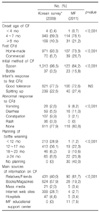
Note: 4~7 mo=4~<8 months, etc. CF: complementary feeding, CFd: complementary food, MF: multicultural family, NS: not significant. *Reference12)
Table 4
Comparison of Correct Answer of Maternal Nutritional Knowledge on Complementary Feeding in Multicultural Family with the 2009 Korean Survey

CFd: complementary food, MF: multicultural family, NS: not significant. *Reference12)
References
1. Seol DH. Child raising and education of marriage-based immigrants in Korea: On the focus of infants. Korean J Pediatr. 2009. 52:403–409.

2. Ministry of Justice. Korea National Statistical Office. Future population estimation of foreign residents. 2008. Gwacheon: Ministry of Justice.
3. Lee CJ, Han AR, Jung KH, Kim HJ. In 2020, one third of infant will be Kosian. [Internet]. The JoongAng Daily. 2006. updated 2006 Apr; cited 2006 Jul 2. Available from:http://article.joins.com/article/article.asp?total_id=2250434.
4. Kim TI, Kim MJ, Kwon YJ, Jun MK. Evaluation of physical growth and developmental status of infants and children of married immigrant women in rural areas. J Korean Acad Child Health Nurs. 2010. 16:164–174.

5. Park JH, Chung JK. Acculturation and identity of immigrant wives of international marriages in Korea. Korean J Woman Psychol. 2007. 12:395–432.

6. Han GS. Family life and cultural encounter of foreign wives in rural area. Korean Cult Anthropol. 2006. 39:195–219.
7. Seol DH. Foreign wives' life in Korea: focusing on the policy of welfare and health. 2005. Ministry of Health and Welfare;101–148.
8. Lim JW. Development and language problems in children of immigrant marriages. Korean J Pediatr. 2009. 52:417–421.

9. Faruque ASG, Ahmed AMS, Ahmed T, Islam MM, Hossain MI, Roy SK, et al. Nutrition: basis for healthy children and mothers in bangladesh. J Health Popul Nutr. 2008. 26:325–339.

10. Moon JS, Kim JY, Chang SH, Choi KH, Yang HR, Seo JK, et al. Development of a nutrition questionnaire and guidelines for the Korea national health screening program for infants and children. Korean J Pediatr Gastroenterol Nutr. 2008. 11:42–55.

11. Yom HW. Review on revised nutrition guidelines of the Korea national health screening program for infants and children. Korean J Pediatr Gastroenterol Nutr. 2010. 13:Suppl 1. S1–S9.

12. Yom HW, Seo JW, Park HS, Choi KH, Chang JY, Ryoo E, et al. Current feeding practices and maternal nutritional knowledge on complementary feeding in Korea. Korean J Pediatr. 2009. 52:1090–1102.

13. Kang IJ. A survey on nutrition knowledge and dietary life of women in multi-cultural families. 2011. Gyeongsangbuk-do: Univ. of Yeungnam.
14. Ko HJ. A study on the dietary habits and nutritional knowledge of marriage-immigrant females in GwangJu and Chonnam province. 2010. GwangJu: Univ. of Chonnam National.
15. Korean National Statistical Office. Population dynamics (Marriage and divorce) database. 2009. Daejeon: Korean National Statistical Office.
16. Chung CS. Pregnancy, delivery and cultural integration of international marriage migrant women. 2011. Gyeongsangnam-do: Univ. of Inje.
17. Cahe OH, Hong DAG. Case study for Vietnamese marriage immigrants' adjustment to Korea. J Korean Living Sci Assoc. 2007. 16:61–73.

18. Northstone K, Rogers I, Emmett P. The ALSPAC Team. Drinks consumed by 18-month-old children: are current recommendations being followed? Eur J Clin Nutr. 2002. 56:236–244.

19. Kleigman RM, Stanton BF, St. Geme JW, Schor NF, Behrman RE. Nelson textbook of pediatrics. 2011. 19th ed. Philadelphia: Saunders;165.
20. Jeong GH, Koh HJ, Kim KS, Kim SH, Kim JH, Park HS, et al. A survey on health management of during pregnancy, childbirth, and the postpartum of immigrant women in a multi-cultural family. Korean J Women Health Nurs. 2009. 15:261–269.

21. Mangels AR, Messina V. Considerations in planning vegan diets: infants. J Am Diet Assoc. 2001. 101:670–677.
22. Kleigman RM, Stanton BF, St. Geme JW, Schor NF, Behrman RE. Nelson textbook of pediatrics. 2011. 19th ed. Philadelphia: Saunders;163–164.
23. Han YH. Influential factor on Korean dietary life and eating behaviour of female marriage immigrants. 2010. Seoul: Univ. of Hanyang.
24. Van Hoan N, Van Phu P, Salvignol B, Berger J, Treche S. Effect of the consumption of high energy dense and fortified gruels on energy and nutrient intakes of 6-10-month-old Vietnamese infants. Appetite. 2009. 53:233–240.

25. Committee on Nutriton Korean Pediatric Society. Nutrition for infants and children. 2000. Seoul: The Korean Pediatric Society.
26. Park HR, Lim YS. A study of effect of weaning foods-feeding methods in weaning periods on preschool-children's food habit food preference and iron nutritional status. Korean J Nutr. 1999. 32:259–267.




 PDF
PDF ePub
ePub Citation
Citation Print
Print


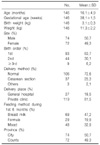
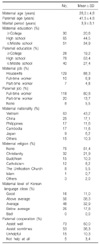
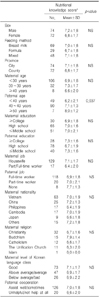
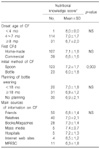
 XML Download
XML Download